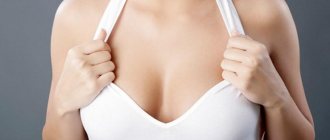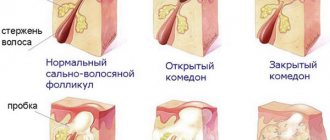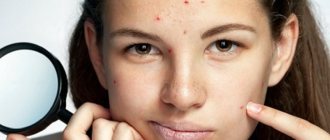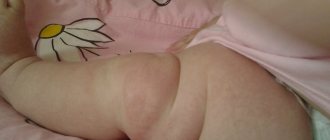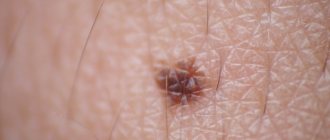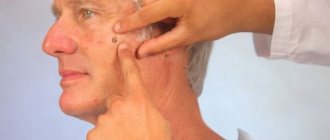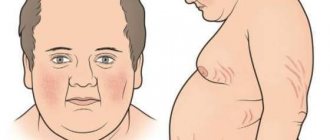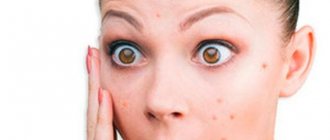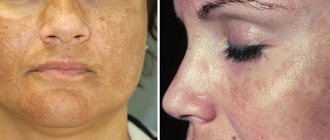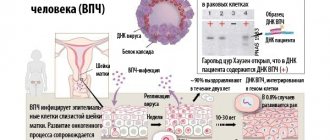Why do rashes appear?
According to statistics, rashes appear on the décolleté and neck as often as on the face. It is no longer a secret to anyone that in this way the human body can report pathologies of systems and internal organs or their unstable functioning. However, not only internal factors influence a person’s appearance.
Pimples on the neck in women and men can occur at any age. Although most often it is young people under 27 who encounter this problem. First of all, when rashes appear on the neck, you need to pay attention to your hygiene and clothing:
- bath procedures should be carried out every day, in the summer - at least twice a day, since the sebaceous and sweat glands work with greater intensity;
- it is better to choose clothes from natural materials, giving preference to cotton, since synthetic fabrics can cause irritation, allergies and even clogged pores, which can cause the formation of comedones and red pimples;
- use the most suitable skin care cosmetics - it is better to use soap for washing the body in liquid form, as it contains less alkali, and when choosing shower gels, pay attention to the composition and pH level, it should not exceed 5.5;
- if necessary, use moisturizers with a non-greasy consistency - body milk, emulsion.
https://www.youtube.com/watch?v=HYIGst5GgsM
There are cases when acne occurs in those with thin and dry skin. This usually happens if the epidermis is too dry and requires moisture, as a result, irritation, redness and small pimples may appear.
As for internal diseases, most often imperfections in the neck indicate pathologies and improper functioning of the gastrointestinal tract. Usually in such situations, diseases of the stomach and intestines are detected.
Boric acid for acne on the face is an effective solution to the problem.
The second internal cause of rashes on the neck is hormonal imbalance or changes. Therefore, most often it is women and adolescents who encounter neoplasms in this area of the body. Often, irritation in this part can appear before the critical days, and then disappear on its own; sometimes cases of rashes on the neck have been noticed during pregnancy.
A rash on the lower jaw and in the area under the chin may indicate problems in the pelvis. Sometimes in men, when such irritations appear, the symptoms coincide with prostatitis, so you definitely need to listen to your body. Also, men often experience irritation in this part of the body due to shaving.
The first thing the dermatologist you contact with a problem will do is prescribe a series of tests. This way, it will be possible to identify why the rash appeared on the neck and chest. The most common causes of the problem include:
- Hormonal changes in the body. The rash most often occurs during adolescence in boys and girls. Sebum begins to be produced more intensely, clogging the pores. As a result, small pimples appear that can be difficult to deal with. Hormonal imbalance can also occur during menopause in women. Many representatives of the fairer sex who have problems with the menstrual cycle also have to suffer from small pimples on the back, face and neck.
- Lack of quality personal hygiene. The problem is more typical for the stronger sex. Even adult men often pay little attention to their neck, forgetting to wash it and clean it of the sweat accumulated during the day. The skin becomes vulnerable to negative factors. If you cut yourself a little while shaving, the small wound will become infected.
- Slagging of the body. Many people know that the condition of the skin is an indicator of the health of the entire body. If a person eats poor quality food, does not neglect alcohol and smokes a lot, over time this will manifest itself as rashes on the skin, including in the neck area. The causes of rashes may also be chronic diseases of the internal organs. In this case, only complex therapy will help. Cosmetics cannot get rid of rashes.
- Allergic reaction. Anything can trigger the appearance of small pimples on the back (on the neck, face or shoulders). Negative reactions from the body can be caused by chocolate, citrus milk, coffee, etc. Even household chemicals can cause a rash. An allergic reaction will have to be dealt with with antihistamines. And you should definitely exclude the allergen and try not to encounter it in the future.
If you cannot explain the appearance of the rash, you should not postpone your visit to the doctor.
Causes of rash in the sternum area
The main cause of chest rashes is improper skin care.
Improper skin care is one of the main factors of rashes. A scattering of acne on the chest appears due to the fact that the pores become clogged with sweat and subcutaneous sebum if you neglect to shower. This is a comfortable environment for the proliferation of pathogenic bacteria, which causes inflammatory processes.
Pimples on the sternum often appear due to a lack of valuable elements. Vitamin deficiency is more likely to affect teenagers, expectant and nursing mothers, and people with heavy physical and mental labor.
If the rash appears together with severe itching and irritation, this may indicate the presence of skin diseases, such as eczema, shingles or one of the types of dermatitis, as well as an infectious process or allergy.
Allergens include pet hair, pollen, household dust, household chemicals, food, alcohol, and medications. For example, it can sprinkle on a person after taking antibiotics or iron supplements. A similar reaction to ultraviolet rays is possible after visiting the beach or solarium.
For the above reasons, a rash in the sternum area occurs in representatives of any gender and age. But there are certain factors that affect men, women or children specifically.
Among women
When pregnancy occurs, a rash may appear on the chest
Changes in estrogen synthesis in the body lead to excess subcutaneous fat, which usually manifests itself as rashes. For hormonal reasons, rashes occur in a woman if she:
- pregnant;
- breastfeed;
- waits from day to day for menstruation;
- had an abortion or lost a fetus;
- entered menopause.
Pimples on the sternum appear due to excess hormone synthesis in adolescents of both sexes.
A rash on the chest in women in the form of scarlet pimples that tend to itch and itch may be a reaction to a poor-quality or tight bra, popularly called urticaria.
Due to the subtle emotional structure of the female psyche, red spots and rashes often occur against the background of stressful situations. They provoke itching and cause significant discomfort. To get rid of it, you should exclude the cause of nervous stress, try to calm down and direct your thoughts in a positive direction. Gradually, your health will return to normal and the rash will disappear.
In men
A rash on the chest in men indicates internal diseases
A rash on the chest in men can indicate internal diseases, in particular, pathologies of the stomach and intestines, kidneys, liver, and prostate. But most often the problem is neglect of personal hygiene rules.
If the rash on the male chest does not disappear within a couple of days even with regular bathing, and the itching and burning only intensify, you should immediately see a therapist or dermatologist.
In children
External manifestation of measles
In newborn babies, rashes can occur in the first days of life as a reaction of the skin to adapt to the new environment. Usually such manifestations pass quickly. In infants, rashes are often associated with the quality of the mother's diet and, accordingly, milk. A formula-fed baby may react with a rash to inappropriate formula.
Common childhood illnesses that cause rashes include:
- Miliaria is a rash of small itchy blisters that occurs due to blockage of the sweat glands due to excessive sweating. Usually concentrates on the abdomen, chest, buttocks.
- Exanthema is a skin rash that looks like spots, papules, vesicles, formed under the influence of pathogenic microorganisms.
- Chickenpox is a viral disease in which blisters grow and burst on the chest, face, arms, and legs.
Infectious diseases, a sign of which is a rash: scarlet fever, rubella, measles, pharyngitis, pyoderma, syphilis, spotted fever, HIV. They are usually accompanied by additional symptoms: fever, body aches, headache, cough, conjunctivitis. These diseases affect not only children, but also adults. Chickenpox or rubella in adulthood is much more severe, with complications. Therefore, at the first appearance of a rash, you should consult a doctor.
Types of the most common allergens
Most often, an allergic reaction in the form of a rash on the body is caused by:
- fungal spores;
- products (strawberries, chocolate, nuts, seafood, citrus fruits);
- medicines;
- plant pollen;
- waste products of helminths;
- animal fur (especially foreign hair);
- plants;
- body fragments of insects and mites;
- household chemicals;
- shower gel;
- washing powder;
- synthetic fabrics;
- nutritional supplements.
Allergens are home (household), industrial and outdoor.
Causes of acne on the chest
Unfortunately, as practice shows, even with large-scale formation of rashes, people do not always turn to a specialist, thereby complicating the situation even more. It is worth noting that acne on the chest and neck, as well as in the back and arms, most often tend to recur.
What are the causes of acne on the chest? Basically, oddly enough, the décolleté area is closely related to the neck area, so often rashes can appear in both parts at the same time and, accordingly, indicate the same problem.
The most popular causes of rashes on the chest:
- blockage of the excretory ducts of the sebaceous and sweat glands, usually in this case white purulent pimples are observed in quite a large number, but small in size - most often appear due to intolerance to any ingredients of cosmetics;
- red pimples on the chest can appear due to disturbances in thermoregulation, which often occurs in the summer, as well as when wearing synthetic clothes or tight-fitting sweaters; for the same reason, pimples under the breasts, which are often called miliaria, can appear;
- unstable functioning of internal organs, hormonal imbalances change the amount of sebum secreted, so acne on the chest often appears during pregnancy and before menstruation;
- the appearance of pimples between the breasts may indicate severe stress and lack of sleep;
- rashes of a purulent nature, which are large in size, but appear in 1-2 units at a time, require mandatory diagnosis, as they can indicate serious diseases, diabetes mellitus;
- Often small pimples on the chest, shoulders and neck occur due to an allergic reaction of the body to food, medicines or plants.
Of course, nutrition, as well as the rhythm of life, also have an important impact on human skin.
Treatment of acne on the neck
Finding out the cause of the rash is the first stage of therapy. A dermatologist will tell you what to do next. In 70% of cases, a rash on the neck is a consequence of hormonal imbalance. Therefore, the specialist selects the appropriate hormonal drug. Purulent rashes can be eliminated with the help of salicylic acid. The product is applied pointwise to problem areas. This treatment is not suitable for those with sensitive skin. Salicylic acid often leads to irritation, which only makes the situation worse.
Zenerit is an excellent remedy for pimples on the face and neck.
You can find a lot of anti-acne products in the pharmacy. If a small rash appears on the neck, the following medications are suitable:
- Zenerite;
- Baziron;
- Curiosin;
- Dalatsin-T;
- Differin.
All these drugs effectively eliminate inflammation and even out skin color. But they cannot influence the cause of the rash in any way. Therefore, the listed medications are most often used as part of complex therapy. In addition, each drug has its own contraindications. Self-medication is not advisable.
Diagnostic methods
To identify allergies you will need:
- patient interview;
- general clinical tests (detect an increase in eosinophils in the blood);
- immunological study (detection of IgE and IgG);
- physical and external examinations;
- allergy tests (prick test, scarification, intradermal and application tests);
- enzyme immunoassay and radioallergosorbent tests (if allergy tests are not possible);
- dermatoscopy;
- Wood's lamp examination (to exclude fungal infection).
If necessary, assess the condition of internal organs.
How can breast allergies be treated?
Treatment involves:
- The use of antihistamines (tablets, syrups, dragees).
- Use of antimicrobial drugs (for infection).
- Use of hormonal agents (corticosteroids).
- Following a hypoallergenic diet. Patients should exclude from the menu food allergens that are found in seafood, nuts, and strawberries.
- Taking sorbents (for food allergies). Polysorb, Enterosgel, Polyphepan or activated carbon are prescribed.
- Stopping exposure to the allergen.
- Rejection of bad habits.
- Elimination of etiological factors (treatment of helminthiases, normalization of hormonal levels).
- Conducting allergen-specific immunotherapy.
- Physiotherapy. For atopic dermatitis, UV irradiation (ultraviolet irradiation) is effective.
- Infusion therapy (to accelerate the removal of the allergen).
It is recommended to consult a doctor before therapy.
For allergic rashes, ointments, creams and gels based on corticosteroids are prescribed. These include:
- Lokoid.
- Advantan.
- Hydrocortisone.
- Comfoderm K.
- Akriderm.
- Triderm.
- Belosalik.
These drugs are prescribed for severe urticaria, itching and contact dermatitis.
Reduce itching, redness, rashes and swelling of the skin. Local agents (Psilo-Balm, Fenistil gel, Dimetinden) and systemic blockers of H1-histamine receptors (Cetrin, Zodak, Cetirizine, Loratadine, Loragexal, Allegra, Claritin, Clarisens, Erius, Zyrtec, Suprastinex, Suprastin, Diazolin) are effective.
Non-traditional methods of treating an allergic rash on the chest include:
- the use of traditional medicine (nettle decoction for oral administration, celery juice, dill juice as lotions, a mixture based on string and chamomile for lotions, raw potatoes);
- taking baths (with oak bark decoction, soda);
- drinking tea with raspberry roots.
The causes of allergies under the breasts are fungal and bacterial infections, excessive sweating, dermatitis (inflammation of the skin), and scabies.
The following bacteria can cause a rash:
- staphylococci;
- streptococci;
- viruses (herpes, measles, rubella);
- meningococci.
Human infection occurs through contact (through the skin) or aerogenic (through the air) route. Bacterial toxins cause allergies, damage blood vessels, which leads to a rash.
The rash is accompanied by the following fungal diseases:
- Pityriasis versicolor. Caused by fungi. Multiple round spots of various colors (brown, yellow, brown, pink) appear in the chest or back area without signs of inflammation.
- Ringworm. A contagious fungal disease that affects the skin, hair and nails. The rash is represented by spots, along the edges of which there is a pink roller of small nodules and blisters. In the central part the spots are pale.
- Microsporia. It is characterized by the appearance of a rash in the form of swollen red ring-shaped spots up to 3 cm in size. At the same time, skin, hair and nails can be affected.
- Actinomycosis. It is characterized by the formation of tubercles on the skin, turning into pustules and fistulas.
These are inflammatory skin diseases of non-microbial etiology. This group includes contact allergic, atopic and simple dermatitis. With this pathology, along with rashes, tissue swelling, hyperemia, itching, tingling and an increase in local temperature are observed.
The cause may be skin contact with detergents and cosmetics (gels, soaps, creams, washing powder), wearing uncomfortable (tight) clothes, taking medications, or contact with animals. The rash in this pathology is localized in a fold of the skin and is represented by small serous blisters.
A common cause of rash and itching is scabies. This is a disease caused by microscopic mites. The rashes are localized on the mammary glands, abdomen, lateral surfaces of the fingers, thighs and buttocks.
The elements of the rash are represented by papules and vesicles. Upon examination, scabies can be detected. Additional symptoms are itching and crusts on the skin.
Possible diseases
Interesting!
Some girls may confuse papillomas under the breasts with serious formations. This is especially true for pregnant women, who, due to hormonal imbalance, develop several dozen formations on the leg in this area. The distinctive features of papillomas are flesh-colored, raised above the surface of the skin and painless.
The appearance of profuse or festering rashes is an alarming sign. Often the body gives a signal in this way about the development of a serious pathology:
- Infectious diseases: chickenpox; measles; rubella; pharyngitis, etc. Accompanied by fever and profuse purulent rashes.
- Diseases of internal organs. The body signals disruptions in the functioning of the gastrointestinal tract, genitourinary and endocrine systems by the appearance of large pimples on the chest and back. In this case, it is useless to fight external manifestations. Rashes will appear until the cause is eliminated.
- Dermatological diseases. Eczema, psoriasis, dermatitis and other skin diseases are accompanied by a red rash on the chest in women, peeling and itching. Bubbles filled with liquid appear. Then the formations burst and become crusty. A visit to a dermatologist and comprehensive treatment is required.
- Inflammatory breast cancer. A rare and aggressive type of oncology. It is expressed in tissue swelling and the absence of palpable seals. The skin becomes covered with red spots and looks like lemon peel. Associated symptoms: pain; feeling of heaviness; nipple retraction; enlargement of nearby lymph nodes; increased body temperature in the chest area.
- Ductectasia. Dilation of the milk ducts not associated with pregnancy and lactation. Dangerously increased risk of inflammation, neoplasms and mastopathy. Clinical picture: change in the shape and location of the nipples; red spots and rough skin around the nipples; burning and itching; pain; white, bloody or purulent discharge from the nipple.
- Mastitis. Inflammatory disease of the mammary glands. At the beginning of the disease, a lump appears in the chest. The skin around the tumor turns red and becomes hot to the touch. Then fever and fever occur. In advanced cases, blood and pus are released from the nipple. Immediate treatment is very important as the disease progresses quickly.
- Allergic reactions. They occur as a reaction to food or external stimuli. Contact dermatitis is caused by cosmetics, perfumes, and clothing. First, a small rash appears on the woman’s chest. If you remove the allergen from your daily life in time, the reaction stops. You can take antihistamines. In advanced cases, extensive purulent foci appear. This can lead to serious consequences, including anaphylactic shock and sepsis.
- Paget's cancer. A type of oncology in which the tumor affects the nipple and areola. It is characterized by peeling of the skin at the site of localization, redness and irritation. Then a painless ulcer or erosion appears in the nipple area. If alarming symptoms occur, you should immediately consult a doctor. Timely diagnosis is the key to a favorable treatment outcome.
- Thrush. Fungal disease. It usually affects the external genitalia, but during breastfeeding the fungi settle in the nipple area. The disease is characterized by the following symptoms: swelling of the nipples; peeling of the skin; blistering rashes; burning pain in the chest. It often occurs against the background of vaginal candidiasis and nail fungus.
As you can see, there are many diseases that need to be diagnosed as early as possible, as they pose a danger to the girl’s health and life.
What should you give up?
If you notice such a problem as a rash on the chest and neck, you first need to seek help from a doctor. After diagnosis, a specific treatment complex is prescribed, which usually includes a diet.
What foods and dishes are best to avoid if a rash appears? First of all, you need to get rid of bad habits, since smoking and alcohol can lead not only to the formation of imperfections, but also become the root cause of serious pathologies of many organs and systems of the human body.
As for the daily menu, it is recommended to exclude from it:
- fatty and fried foods;
- spicy food and lots of spices;
- sweet and flour products;
- sour and salty vegetables.
Instead, it is better to switch to a completely healthy diet, in which most dishes will be boiled or steamed, and only small quantities of oatmeal cookies will remain from sweets. Be sure to include fresh fruits and vegetables in your daily diet; you can drink freshly squeezed juices.
By the way, the amount of water you drink is also important for our skin. You need to drink at least 1.5 liters of clean water per day. At the same time, many dermatologists recommend eliminating coffee and strong black tea from your diet, replacing them with green tea, which also has a great effect on your figure.
Treatment
If the appearance of a defect is not associated with pathological processes in the body, it is easy to cope with a rash on the chest in women on your own. Minor rashes disappear after treatment with cosmetic or pharmaceutical anti-inflammatory agents. In addition, it is important to follow preventive measures:
- take a shower regularly, especially in the heat and after physical activity;
- refuse synthetic clothing and tight underwear;
- stop taking oral contraceptives;
- for nervous tension, take natural sedatives;
- exclude foods that cause acne from your diet;
- in case of allergies, reduce contact with the irritant;
- do not squeeze out ulcers;
- do not use aggressive cleansing methods, such as a hard washcloth or scrub.
If the rash does not go away for a long time, becomes more profuse, or becomes very inflamed, you should consult a dermatologist. The doctor will prescribe the necessary tests, on the basis of which he will refer you to the appropriate specialist or draw up a treatment regimen.
Women of all ages suffer from rashes in the chest area. Many people are accustomed to not attaching much importance to defects that are invisible to the prying eye. But it's not right. A seemingly harmless rash is often a warning from the body about serious problems in its functioning.
